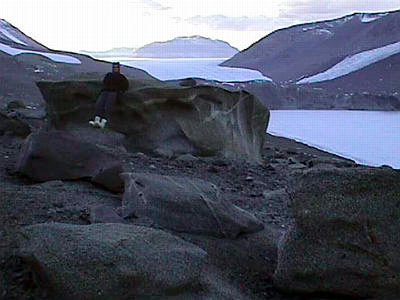
|
|
Disappearing Rocks
How Erosion Creates Ventifacts
data
| hook
| main
| background & resources
| student
Hook
In 1998, I joined a research team from Montana State University and traveled to the Antarctica Dry Valleys to study life in the ice. The remarkable thing about the Dry Valleys is that it is a cold desert. It looks like one, too, except for the glaciers spilling down over the mountainsides. The land surface is covered with dirt and small pebbles. Large boulders dot the landscape. Higher up on the mountains, closer to the glaciers, there are strange-looking rock shapes. These are called ventifacts. Ventifacts are stones that have been eroded by windblown parcticles, such as dry sand. Some of them are quite bizarre, with holes, grooves, or thin "arms" that jut out. This lesson looks at erosion--how it affects different materials and why itís important.

(View across the lake from our camp, Lake Bonney, Dry Valleys, Antarctica, 1998)

(Elissa Elliott leaning against a ventifact, 1998)
Return to top of page
Back to: TEA Activities Page
data
| hook
| main
| background & resources
| student
|



